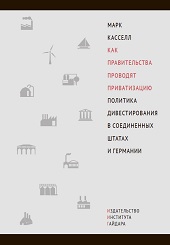How Governments Privatize: The Politics of Divestment in the United States and Germany

Mark Cassell
Translated to Russian by T. Drobyshevskaya, Yu. Kapturevsky and D. Uzlaner; under scientific editing by D. Shestakov. Moscow, Gaidar Institute Press, 2016. – 416 p.
ISBN 978‑5‑93255‑448‑7
Governments throughout the world confront enormous challenges when divesting. Whether it is poor-performing bank loans in Japan and Korea, military bases in the United States, or real estate in eastern Europe, the challenge of public divestment is more than just a question of how to map a path to economic efficiency. Conventional wisdom in public management and privatization literature says that the execution of such enormous tasks as divestment is typically done poorly, and that the government strategy is likely to be inefficient.
Mark Cassell argues that privatization must be understood as a political and administrative puzzle rather than simply an exercise in economic efficiency. This study of two successful divestment agencies – the U.S. Resolution Trust Corporation and the German Treuhandanstalt – presents a complex understanding of the two agencies' performance in privatizing hundreds of billions of dollars of assets following two very different crises, the savings and loan debacle in the United States and unification in Germany. In the U.S., the worst economic problem since the Great Depression forced the government to recreate and reshape private property on an immense scale. In Germany, melding East and West Germany involved converting an entire national economy that employed more than four million people. In each case, unassuming public agencies handled two of the largest public sales of assets in this century.
Cassell identifies the importance and effects of managerial structures and of national institutions – legislatures and executives – on the outcomes of the reform efforts.